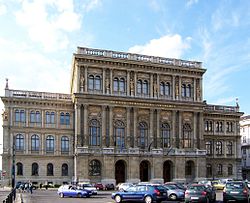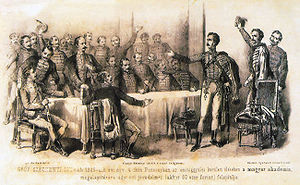- Hungarian Academy of Sciences
-
Hungarian Academy of Sciences 
Abbreviation HAS Formation November 3, 1825 [1] Type national academy Headquarters Budapest Coordinates 47°30′05″N 19°02′47″E / 47.5013°N 19.0463°E Region served Hungary President József Pálinkás Website mta.hu The Hungarian Academy of Sciences (in short: HAS; Hungarian: Magyar Tudományos Akadémia, MTA) is the most important and prestigious learned society of Hungary. Its seat is at the bank of the Danube in Budapest.
Contents
History
The history of the academy began in 1825, when Count István Széchenyi offered one year's income of his estate for the purposes of a Learned Society at a district session of the Diet in Pressburg (Pozsony, present Bratislava, seat of the Hungarian Parliament at the time), and his example was followed by other delegates. Its task was specified as the development of the Hungarian language and the study and propagation of the sciences and the arts in Hungarian. It received its current name in 1845. Its central building was inaugurated in 1865, in neo-Renaissance style.
Sections of the Hungarian Academy of Sciences
 Count István Széchenyi offers one year's income of his estate for the purposes of a Learned Society.
Count István Széchenyi offers one year's income of his estate for the purposes of a Learned Society.
Today it has eleven main sections:
- I. Linguistics and Literary Studies Section
- II. Philosophy and Historical Studies Section,
- III. Mathematical Sciences Section,
- IV. Agricultural Sciences Section,
- V. Medical Sciences Section,
- VI. Technical Sciences Section,
- VII. Chemical Sciences Section,
- VIII. Biological Sciences Section,
- IX. Economics and Law Section,
- X. Earth Sciences Section,
- XI. Physical Sciences Section.
Presidents of the Hungarian Academy of Sciences
József Teleki November 17, 1830 - February 15, 1855 Emil Dessewffy 1855. April 17, 1855 – January 10, 1866 József Eötvös March 18, 1866 – February 2, 1871 Menyhért Lónyay May 17, 1871 – November 3, 1884 Ágoston Trefort May 28, 1885 – August 22, 1888 Loránd Eötvös May 3, 1889 – October 5, 1905 Albert Berzeviczy November 27, 1905 – March 22, 1936 Joseph Habsburg March 22, 1936 – October 1944 Gyula Kornis March 7, 1945 – October 29, 1945 Gyula Moór October 29, 1945 – July 24, 1946 Zoltán Kodály July 24, 1946 – November 29, 1949 István Rusznyák November 29, 1949 – February 5, 1970 Tibor Erdey-Grúz February 5, 1970 – August 16, 1976 János Szentágothai October 26, 1976 – May 6, 1977 János Szentágothai May 6, 1977 – May 10, 1985 Iván Berend May 10, 1985 – May 24, 1990 Domokos Kosáry May 24, 1990 – May 9, 1996 Ferenc Glatz May 9, 1996 – May 4, 2002 Szilveszter Vizi May 5, 2002 – May 6, 2008 József Pálinkás May 6, 2008 Research institutes
- ATOMKI, Institute of Nuclear Research
- Research Institute for Linguistics
- Computer and Automation Research Institute (SZTAKI)
- Alfréd Rényi Institute of Mathematics
- KFKI Research Institutes
- Biological Research Centre, Szeged
- Chemical Research Center of the HAS
- HAS Research Institute of Philosophy
- HAS Institute for Psychology
Széchenyi Academy of Literature and Arts
Main article: Széchenyi Academy of Literature and ArtsThe Széchenyi Academy of Literature and Arts (Hungarian: Széchenyi Irodalmi és Művészeti Akadémia) was created in 1992 as an academy associated yet independent from the HAS. Some of the known members are György Konrád, Magda Szabó, Péter Nádas writers, Zoltán Kocsis pianist, Miklós Jancsó, István Szabó film directors.The president is László Dobszay musical historian.
References
- ^ "A Magyar Tudományos Akadémiáról" (in Hungarian). MTA. http://mta.hu/cikkek/akademiarol__22321. Retrieved 24 February 2011.
External links
- Official website
- Brief history of the Hungarian Academy of Sciences (in English)
- Hungarian Academy of Sciences (in English) -- also available in Hungarian
- Picture of its central building -- additional picture
- homepage of the Széchenyi Academy
International Council for Science (ICSU) National Members Albania · Angola · Argentina · Armenia · Australia · Austria · Azerbaijan · Bangladesh · Belarus · Belgium · Bolivia · Bosnia & Herzegovina (Academy of Sciences and Arts of Bosnia and Herzegovina • Academy of Sciences and Arts of the Republic of Srpska) · Botswana · Brazil · Bulgaria · Burkina Faso · Cameroon · Canada · Caribbean · Chile · China · Colombia · Costa Rica · Croatia · Cuba · Czech Republic · Côte d'Ivoire · Denmark · Dominican Republic · Egypt · Estonia · Ethiopia · Finland · France · Georgia · Germany · Ghana · Greece · Guatemala · Hungary · India · Indonesia · Iran · Iraq · Ireland · Israel · Italy · Jamaica · Japan · Jordan · Kazakhstan · Kenya · Laos · Latvia · Lebanon · Lesotho · Lithuania · Luxembourg · Macedonia · Madagascar · Malawi · Malaysia · Mauritius · Mexico · Moldova · Monaco · Mongolia · Montenegro · Morocco · Mozambique · Namibia · Nepal · Netherlands · New Zealand · Nigeria · North Korea · Norway · Pakistan · Panama · Peru · Philippines · Poland · Portugal · Romania · Russia · Rwanda · Saudi Arabia · Senegal · Serbia · Seychelles · Singapore · Slovakia · Slovenia · South Africa · South Korea · South Pacific · Spain · Sri Lanka · Sudan · Swaziland · Sweden · Switzerland · Taiwan · Tajikistan · Tanzania · Thailand · Togo · Tunisia · Turkey · Uganda · Ukraine · United Kingdom · United States · Uruguay · Uzbekistan · Vatican City · Venezuela · Vietnam · Zambia · Zimbabwe
International Scientific Unions International Astronomical Union (IAU) · International Brain Research Organization (IBRO) · International Geographical Union (IGU) · International Mathematical Union (IMU) · International Society for Photogrammetry and Remote Sensing (ISPRS) · International Union for Physical and Engineering Sciences in Medicine (IUPESM) · International Union for Pure and Applied Biophysics (IUPAB) · International Union for Quaternary Research (INQUA) · International Union of Anthropological and Ethnological Sciences (IUAES) · International Union of Basic and Clinical Pharmacology (IUPHAR) · International Union of Biochemistry and Molecular Biology (IUBMB) · International Union of Biological Sciences (IUBS) · International Union of Crystallography (IUCr) · International Union of Food Science & Technology (IUFoST) · International Union of Forest Research Organizations (IUFRO) · International Union of Geodesy and Geophysics (IUGG) · International Union of Geological Sciences (IUGS) · International Union of History and Philosophy of Science (IUHPS) · International Union of Immunological Societies (IUIS) · International Union of Materials Research Societies (IUMRS) · International Union of Microbiological Societies (IUMS) · International Union of Nutritional Sciences (IUNS) · International Union of Physiological Sciences (IUPS) · International Union of Psychological Science (IUPsyS ) · International Union of Pure and Applied Chemistry (IUPAC) · International Union of Pure and Applied Physics (IUPAP) · International Union of Radio Science (URSI) · International Union of Soil Sciences (IUSS) · International Union of Theoretical and Applied Mechanics (IUTAM) · International Union of Toxicology
Scientific Associates Academia de Ciencias de América Latina (ACAL) · Engineering Committee on Oceanic Resources (ECOR) · Federation of Asian Scientific Academies and Societies (FASAS) · International Arctic Science Committee (IASC) · International Association for Hydro-Environment Engineering and Research (IAHR) · International Cartographic Association (ICA) · International Commission for Acoustics (ICA) · International Commission for Optics (ICO) · International Council for Laboratory Animal Science (ICLAS) · International Council for Scientific and Technical Information (ICSTI) · International Federation for Information Processing (IFIP) · International Federation of Library Associations and Institutions (IFLA) · International Federation of Societies for Microscopy (IFSM) · International Federation of Surveyors (FIG) · International Foundation for Science (IFS) · International Institute for Applied Systems Analysis (IIASA) · International Union for Vacuum Science, Technique and Applications (IUVSTA) · International Union of Speleology (UIS) · International Water Association (IWA) · Pacific Science Association (PSA) · Society for Social Studies of Science (4S) · TWAS, the academy of sciences for the developing world
Coordinates: 47°30′3.88″N 19°2′47.4″E / 47.5010778°N 19.0465°E
Categories:- National academies of arts and humanities
- National academies of sciences
- Hungarian culture
- Organisations based in Hungary
- Hungarian Academy of Sciences
- Buildings and structures in Budapest
- Organizations established in 1825
Wikimedia Foundation. 2010.
